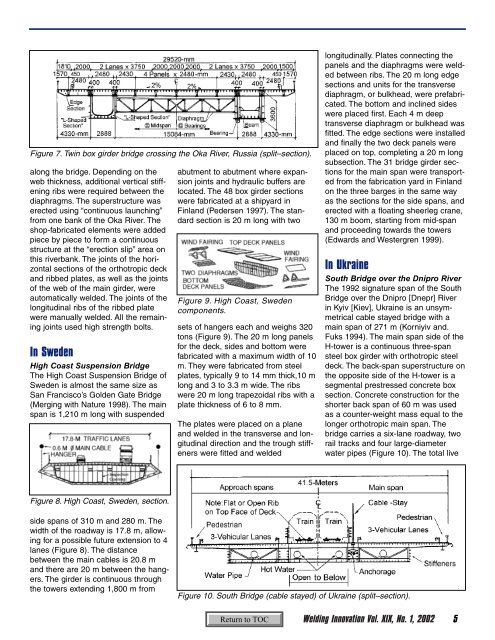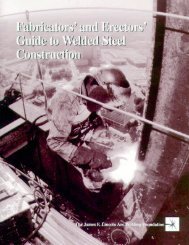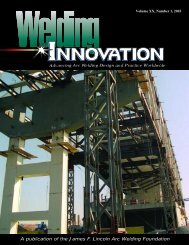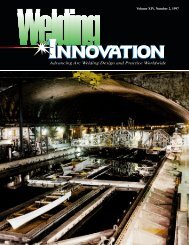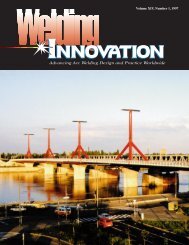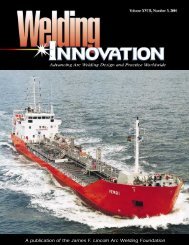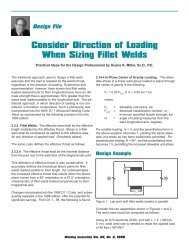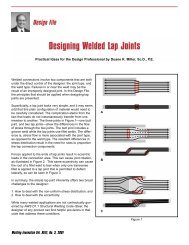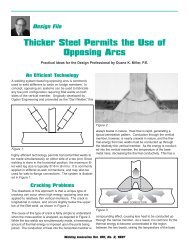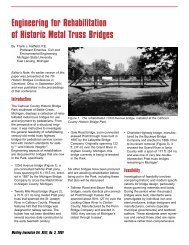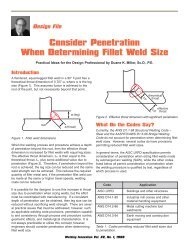A publication of the James F. Lincoln Arc Welding Foundation
A publication of the James F. Lincoln Arc Welding Foundation
A publication of the James F. Lincoln Arc Welding Foundation
Create successful ePaper yourself
Turn your PDF publications into a flip-book with our unique Google optimized e-Paper software.
Figure 7. Twin box girder bridge crossing <strong>the</strong> Oka River, Russia (split–section).<br />
along <strong>the</strong> bridge. Depending on <strong>the</strong><br />
web thickness, additional vertical stiffening<br />
ribs were required between <strong>the</strong><br />
diaphragms. The superstructure was<br />
erected using “continuous launching”<br />
from one bank <strong>of</strong> <strong>the</strong> Oka River. The<br />
shop-fabricated elements were added<br />
piece by piece to form a continuous<br />
structure at <strong>the</strong> “erection slip” area on<br />
this riverbank. The joints <strong>of</strong> <strong>the</strong> horizontal<br />
sections <strong>of</strong> <strong>the</strong> orthotropic deck<br />
and ribbed plates, as well as <strong>the</strong> joints<br />
<strong>of</strong> <strong>the</strong> web <strong>of</strong> <strong>the</strong> main girder, were<br />
automatically welded. The joints <strong>of</strong> <strong>the</strong><br />
longitudinal ribs <strong>of</strong> <strong>the</strong> ribbed plate<br />
were manually welded. All <strong>the</strong> remaining<br />
joints used high strength bolts.<br />
In Sweden<br />
High Coast Suspension Bridge<br />
The High Coast Suspension Bridge <strong>of</strong><br />
Sweden is almost <strong>the</strong> same size as<br />
San Francisco’s Golden Gate Bridge<br />
(Merging with Nature 1998). The main<br />
span is 1,210 m long with suspended<br />
abutment to abutment where expansion<br />
joints and hydraulic buffers are<br />
located. The 48 box girder sections<br />
were fabricated at a shipyard in<br />
Finland (Pedersen 1997). The standard<br />
section is 20 m long with two<br />
Figure 9. High Coast, Sweden<br />
components.<br />
sets <strong>of</strong> hangers each and weighs 320<br />
tons (Figure 9). The 20 m long panels<br />
for <strong>the</strong> deck, sides and bottom were<br />
fabricated with a maximum width <strong>of</strong> 10<br />
m. They were fabricated from steel<br />
plates, typically 9 to 14 mm thick,10 m<br />
long and 3 to 3.3 m wide. The ribs<br />
were 20 m long trapezoidal ribs with a<br />
plate thickness <strong>of</strong> 6 to 8 mm.<br />
The plates were placed on a plane<br />
and welded in <strong>the</strong> transverse and longitudinal<br />
direction and <strong>the</strong> trough stiffeners<br />
were fitted and welded<br />
longitudinally. Plates connecting <strong>the</strong><br />
panels and <strong>the</strong> diaphragms were welded<br />
between ribs. The 20 m long edge<br />
sections and units for <strong>the</strong> transverse<br />
diaphragm, or bulkhead, were prefabricated.<br />
The bottom and inclined sides<br />
were placed first. Each 4 m deep<br />
transverse diaphragm or bulkhead was<br />
fitted. The edge sections were installed<br />
and finally <strong>the</strong> two deck panels were<br />
placed on top, completing a 20 m long<br />
subsection. The 31 bridge girder sections<br />
for <strong>the</strong> main span were transported<br />
from <strong>the</strong> fabrication yard in Finland<br />
on <strong>the</strong> three barges in <strong>the</strong> same way<br />
as <strong>the</strong> sections for <strong>the</strong> side spans, and<br />
erected with a floating sheerleg crane,<br />
130 m boom, starting from mid-span<br />
and proceeding towards <strong>the</strong> towers<br />
(Edwards and Westergren 1999).<br />
In Ukraine<br />
South Bridge over <strong>the</strong> Dnipro River<br />
The 1992 signature span <strong>of</strong> <strong>the</strong> South<br />
Bridge over <strong>the</strong> Dnipro [Dnepr] River<br />
in Kyiv [Kiev], Ukraine is an unsymmetrical<br />
cable stayed bridge with a<br />
main span <strong>of</strong> 271 m (Korniyiv and.<br />
Fuks 1994). The main span side <strong>of</strong> <strong>the</strong><br />
H-tower is a continuous three-span<br />
steel box girder with orthotropic steel<br />
deck. The back-span superstructure on<br />
<strong>the</strong> opposite side <strong>of</strong> <strong>the</strong> H-tower is a<br />
segmental prestressed concrete box<br />
section. Concrete construction for <strong>the</strong><br />
shorter back span <strong>of</strong> 60 m was used<br />
as a counter-weight mass equal to <strong>the</strong><br />
longer orthotropic main span. The<br />
bridge carries a six-lane roadway, two<br />
rail tracks and four large-diameter<br />
water pipes (Figure 10). The total live<br />
Figure 8. High Coast, Sweden, section.<br />
side spans <strong>of</strong> 310 m and 280 m. The<br />
width <strong>of</strong> <strong>the</strong> roadway is 17.8 m, allowing<br />
for a possible future extension to 4<br />
lanes (Figure 8). The distance<br />
between <strong>the</strong> main cables is 20.8 m<br />
and <strong>the</strong>re are 20 m between <strong>the</strong> hangers.<br />
The girder is continuous through<br />
<strong>the</strong> towers extending 1,800 m from<br />
Figure 10. South Bridge (cable stayed) <strong>of</strong> Ukraine (split–section).<br />
<strong>Welding</strong> Innovation Vol. XIX, No. 1, 2002 5


